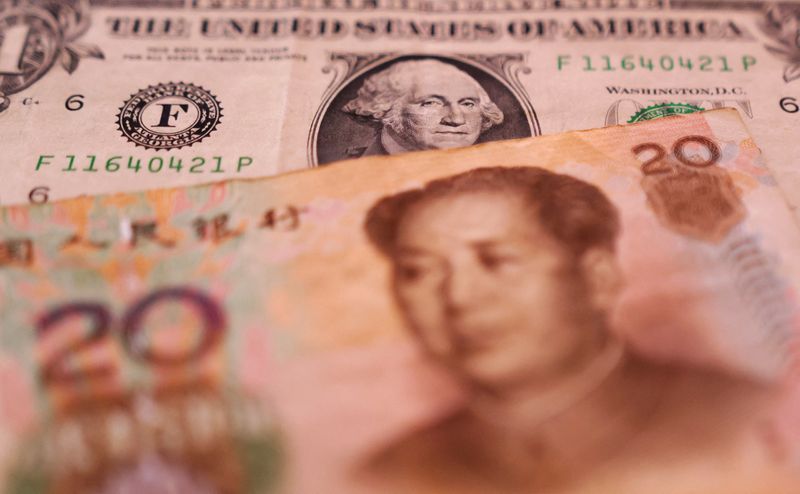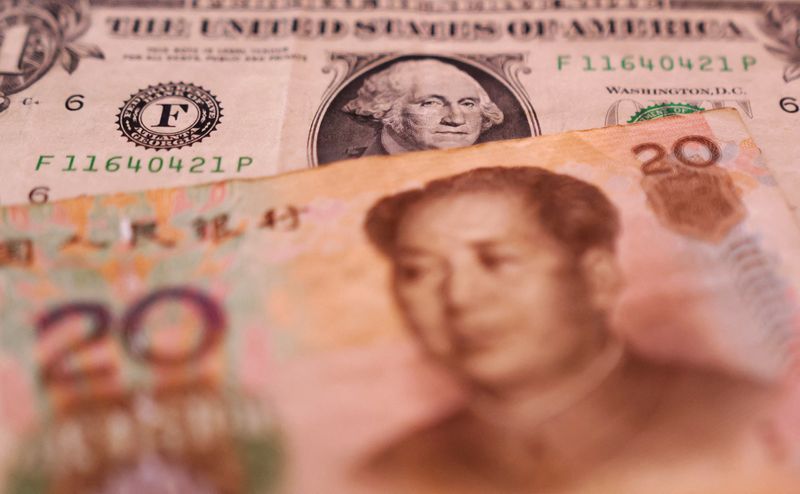Forex
Analysis-China’s cycle of dollar hoarding and weakening yuan gets vicious

SHANGHAI (Reuters) – Chinese businesses are hoarding dollars because they expect their own currency to weaken, and that in turn is exacerbating a slide in the yuan that has been driven by wobbly stock markets and feeble growth in the world’s second largest economy.
This feedback loop has been playing out for months in mainland currency markets, spurred on by the dollar’s rising yield. Foreign exchange deposits have climbed $53.7 billion since September to $832.6 billion, People’s Bank of China (PBOC) data shows.
Analysts say one of two things needs to happen to end the downward spiral: the Federal Reserve needs to make deep rate cuts or the yuan needs to hit some form of a trough. Both seem distant.
is at five-month lows and has lost 1.9% to the dollar this year as foreign investors pull more money out of its struggling markets. The currency has fallen from around 6.7 per dollar at the start of 2023 to around 7.24 currently, a 5% drop.
Regular inflows from domestic exporters have dried up, as businesses choose to park their dollars offshore in deposits that earn them 6%, compared to 1.5% on yuan deposits at home, and just wait for better exchange rates.
Yu Zuochen, a director at Goertek Inc, a Chinese electronic equipment maker, told a forum in the coastal city of Ningbo in late March that exporters were “winning by lying flat”, referring to their foreign exchange gains.
“The rate differential between U.S. and China is the most positive since 2007, and I think this powerful fundamental fact is enough to explain why Chinese exporters are reluctant to exchange dollars for yuan,” said Alvin Tan, head of Asia FX strategy at RBC Capital Markets. “This huge positive yield spread is not evaporating anytime soon.”
Even for companies that choose to bring their dollars home, while authorities have capped dollar deposit rates at major lenders at 2.8% since the middle of last year, there are other dollar-based wealth-management products that invest in overseas funds offering as much as 4.4% for 7-day investments.
Becky Liu, head of China macro strategy at Standard Chartered (OTC:), says a “confirmation of the Fed rate cut including a clearer dollar softening trend” could be a catalyst for corporates to convert their foreign exchange into yuan.
However, if the recent string of robust inflation and economic data in the United States is anything to go by, Fed rate cuts are being pushed out to the end of 2024 and the dollar is on a tear.
That means it is more likely the yuan may hit 7.3, at which level exporters may bring dollars home, sensing authorities may shield it at that level. It was roughly the trough for the yuan in both October 2022 and July 2023.
Several investment banks also predict the yuan will weaken to 7.3 per dollar by the third quarter of this year, but no further. A Shanghai-based banker who deals with corporates said some of his clients are now eyeing 7.3 as the level to sell their dollars.
TERMS OF TRADE
Chinese authorities do not seem unduly perturbed by this accumulation of dollars by businesses and citizens. State banks that normally act on behalf of the People’s Bank of China (PBOC) have been buying the yuan to stem its slide.
The PBOC did not respond to a Reuters request for comments.
Lemon Zhang, a strategist at Barclays, says exporters’ “reluctance to convert their FX receipts will likely continue for the next two quarters”.
She does not expect Chinese regulators to force exporters to settle their FX receipts, but says there could instead be smaller macro prudential or tax relief measures to encourage conversion.
Despite the decline, the yuan has not fallen as far and fast as currencies of some of its trading partners, notably Japan whose yen is down 9% this year, which has eroded China’s trade competitiveness and dented its trade surplus.

China’s goods trade surplus fell 11% to $593.9 billion in 2023 from a year earlier.
Analysts at China Construction Bank (OTC:) estimate the FX settlement ratio, which measures conversion of export receipts to yuan, was just 51% in February as corporate clients placed dollars in deposits.

 Forex3 years ago
Forex3 years agoForex Today: the dollar is gaining strength amid gloomy sentiment at the start of the Fed’s week

 Forex3 years ago
Forex3 years agoUnbiased review of Pocket Option broker

 Forex3 years ago
Forex3 years agoDollar to pound sterling exchange rate today: Pound plummeted to its lowest since 1985

 Forex3 years ago
Forex3 years agoHow is the Australian dollar doing today?

 Cryptocurrency3 years ago
Cryptocurrency3 years agoWhat happened in the crypto market – current events today

 World3 years ago
World3 years agoWhy are modern video games an art form?

 Commodities3 years ago
Commodities3 years agoCopper continues to fall in price on expectations of lower demand in China

 Economy3 years ago
Economy3 years agoCrude oil tankers double in price due to EU anti-Russian sanctions
























